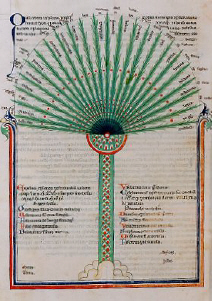DISTINCTIONS IN “WE” AND THE “REAL MAN.”
10. But if “we” are the “soul,” we must admit that when we experience passions, the soul experiences them also; that when we act, the soul acts. We may even say that the common part is also “ours,” especially before philosophy separated the soul from the body1; in fact, we even say “we” suffer, when our body suffers. “We” is, therefore, taken in a double sense: either the soul with the animal part, or living body; or simply the upper part; while the vivified body is a wild beast.
REAL MAN DIFFERS FROM BODY.
The real Man differs from the body; pure from every passion, he possesses the intellectual virtues, virtues which reside in the soul, either when she is separated from the body, or when she is—as usually here below—only separable by philosophy; for even when she seems to us entirely separated, the soul is, in this life, ever accompanied by a lower (IV. 3.19, 23.) sensitive part, or part of growth, which she illuminates2.
FUNCTION OF THE COMMON PART.
As to the virtues which consist not in wisdom, but in ethical habits and austerities, they belong to the common part. To it alone, also, are vices to be imputed, inasmuch as it exclusively experiences envy, jealousy and cowardly pity. Friendships, however, should be referred some to the common part, and others to the pure Soul or inner Man. In childhood, the faculties of the composite common part are exercised, but rarely is it illuminated from above. When this superior principle seems inactive in relation to us, it is actively engaged towards the upper intelligible world; and it only begins to be active towards us when it advances as far as3 (fancy or representation), the middle part of our being.
3829881
{3829881:CXDHNJW9}
1
associacao-brasileira-de-normas-tecnicas
50
default
4710
https://platonismo.hyperlogos.info/wp-content/plugins/zotpress/
%7B%22status%22%3A%22success%22%2C%22updateneeded%22%3Afalse%2C%22instance%22%3Afalse%2C%22meta%22%3A%7B%22request_last%22%3A0%2C%22request_next%22%3A0%2C%22used_cache%22%3Atrue%7D%2C%22data%22%3A%5B%7B%22key%22%3A%22CXDHNJW9%22%2C%22library%22%3A%7B%22id%22%3A3829881%7D%2C%22meta%22%3A%7B%22creatorSummary%22%3A%22GUTHRIE%22%2C%22parsedDate%22%3A%222017%22%2C%22numChildren%22%3A0%7D%2C%22bib%22%3A%22%3Cdiv%20class%3D%5C%22csl-bib-body%5C%22%20style%3D%5C%22line-height%3A%201.35%3B%20%5C%22%3E%5Cn%20%20%3Cdiv%20class%3D%5C%22csl-entry%5C%22%3EGUTHRIE%2C%20K.%20S.%20%3Cb%3EPlotinus%3A%20Complete%20Works%3A%20In%20Chronological%20Order%2C%20Grouped%20in%20Four%20Periods.%20%5Bsingle%20Volume%2C%20Unabridged%5D%3C%5C%2Fb%3E.%20%5Bs.l.%5D%20CreateSpace%20Independent%20Publishing%20Platform%2C%202017.%20%3C%5C%2Fdiv%3E%5Cn%3C%5C%2Fdiv%3E%22%2C%22data%22%3A%7B%22itemType%22%3A%22book%22%2C%22title%22%3A%22Plotinus%3A%20Complete%20Works%3A%20In%20Chronological%20Order%2C%20Grouped%20in%20Four%20Periods.%20%5Bsingle%20Volume%2C%20Unabridged%5D%22%2C%22creators%22%3A%5B%7B%22creatorType%22%3A%22author%22%2C%22firstName%22%3A%22Kenneth%20Sylvan%22%2C%22lastName%22%3A%22GUTHRIE%22%7D%5D%2C%22abstractNote%22%3A%22%22%2C%22date%22%3A%222017%22%2C%22language%22%3A%22%22%2C%22ISBN%22%3A%22978-1-974518-96-8%22%2C%22url%22%3A%22https%3A%5C%2F%5C%2Fbooks.google.com.br%5C%2Fbooks%3Fid%3Deof4swEACAAJ%22%2C%22collections%22%3A%5B%5D%2C%22dateModified%22%3A%222023-10-21T16%3A49%3A01Z%22%7D%7D%5D%7D
GUTHRIE, K. S. Plotinus: Complete Works: In Chronological Order, Grouped in Four Periods. [single Volume, Unabridged]. [s.l.] CreateSpace Independent Publishing Platform, 2017.
